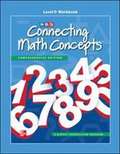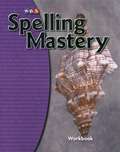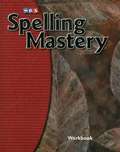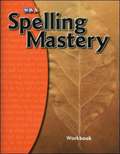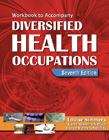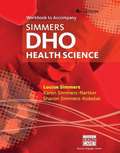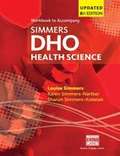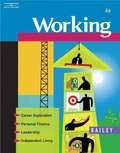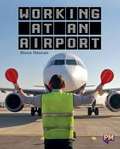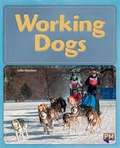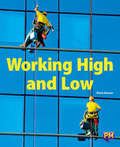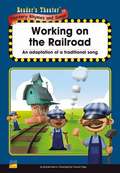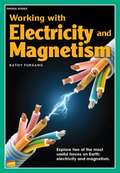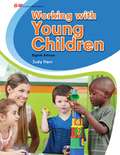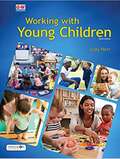- Table View
- List View
More NIMAC books are available at www.nimac.us. If you find your title in the NIMAC and not in Bookshare then please contact us to request it.
Workbook, Level D (SRA Connecting Math Concepts)
by Siegfried Engelmann Jerry Silbert Owen EngelmannNIMAC-sourced textbook
Workbook, Level F [Grade 6]
by Robert Dixon Siegfried Engelmann Donald SteelySpelling Mastery, Student Workbooks, Level F Replacing the old assign-and-test spelling book, Spelling Mastery is an effective, research-based program presents spelling strategies, patterns, and reliable rules. Benefits: Spelling Mastery interweaves three spelling strategies according to students' skill development. The phonemic approach helps beginning spellers learn and apply relationships between spoken sound and written letters to spelling. The morphemic approach shows advanced spellers how to spell prefixes, bases, suffixes and how to combine them to spell multisyllabic words. The intensive whole-word approach teaches students at all levels common words that cannot be taught with phonemic or morphemic strategies. Reliable spelling rules help students move beyond memorization to understand how words are spelled.
Workbook, Level A [Grade 1]
by Robert Dixon Siegfried Engelmann Mary Meier BauerNIMAC-sourced textbook
Workbook to Accompany Diversified Health Occupations, 7th Edition
by Louise Simmers Karen Simmers-Nartker Sharon Simmers-KobelakThis workbook, updated to reflect the Diversified Health Occupations, seventh edition text, contains perforated, performance-based assignment and evaluation sheets. The assignment sheets help students review what they have learned. The evaluation sheets provide criteria or standards for judging student performance for each procedure in the text.
Workbook to Accompany Simmers DHO Health Science
by Louise Simmers Karen Simmers-Nartker Sharon Simmers-KobelakThe workbook, updated to refl ect the eight edition text, contains perforated, performance-based assignment and evaluation sheets. The assignment sheets help students review what they have learned. The evaluation sheets provide criteria or standards for judging student performance for each procedure in the text.
Workbook to Accompany Simmers DHO Health Science
by Louise Simmers Karen Simmers-Nartker Sharon Simmers-KobelakNIMAC-sourced textbook
Working
by Larry J. BaileyThis revision of Working: Career Success for the 21st Century introduces high school seniors and community college students to career planning, working, money management, and essential skills for independent living. Learning features include chapter summaries, activities, and vocabulary exercises, plus boxes on high growth occupations, math connections, and career decision making. This edition spans the entire life/work cycle, and material reflecting the Department of Education's 16 career clusters has been added. Bailey is affiliated with the Department of Workforce Education and Development. Annotation ©2006 Book News, Inc. , Portland, OR (booknews. com)
Working at an Airport (Into Reading, Level S #43)
by Diana NoonanNIMAC-sourced textbook <p><p> Airports are very busy and exciting places that thousands of people go through every day. Many people work at airports, doing a variety of jobs. From security staff and baggage handlers to air traffic controllers and firefighters, everyone who works at an airport plays an important role.
Working at Night (Fountas & Pinnell Classroom, Guided Reading Grade 2)
by Sondra AlanNIMAC-sourced textbook
Working Dogs (Into Reading, Level L #14)
by Julie HaydonNIMAC-sourced textbook <p><p> Working dogs use their senses in many ways. They protect people, animals, and objects. Working dogs can guide people who are blind and pull heavy sleds. They can even be in movies or on television!
Working Dogs
by Jessica QuiltyThe fun and excitement of English and Language Arts learning continues in Grade 2 of Reading Street. This comprehensive and dynamic curriculum for homeschooling is geared toward young children who have some foundational English and Language Arts knowledge and are ready to strengthen their skills. Comprised of engaging activities, challenging content and weekly quizzes, Reading Street: Grade 2 is the next step in your child's path toward becoming a lifelong learner and reader. As with all Reading Street products, the Grade 2 system is formatted to help students meet certain age-appropriate goals. After completing this English and Language Arts homeschool program, your child should be able to: Read and comprehend two-syllable words. Identify common prefixes (such as pre-, un-, or re-) and suffixes (such as -able, -ad and -er). Correct mistakes made when reading out loud. Read books with two or more chapters. Understand the structure of stores (i. e. beginning, middle and end). Start selecting reading materials based on his/her own interests. Identify the "who," "what," "when," "where," "why" and "how" of the text. While the goals of second Grade English and Language Arts are numerous, Reading Street will help you craft engrossing lessons. Your child will garner important English and Language Arts skills while completing a workbook, reading stories and poems, and taking assessments. Planning these lessons will be easier than ever, as all Reading Street systems are broken down into weekly Big Ideas. All the work your child does on a given week is formulated around that single concept for an organized and challenging curriculum. With six easy-to-follow units, Reading Street: Grade 2 is the perfect tool for homeschooling parents. Your child will enjoy the reading selections and activities, and you'll love to see your student growing into a knowledgeable individual. We're confident that this product is the right one for you. For more information on the specific materials found in Grade 2 of Reading Street, check out the Features and Benefits page.
Working Hand in Hand, Pathfinder Edition (National Geographic Explorer Collection)
by Diane G. SilverNIMAC-sourced textbook
Working Hand in Hand, Pioneer Edition (National Geographic Explorer Collection)
by Diane G. SilverNIMAC-sourced textbook
Working Hard to Help (Reach Into Phonics Ser.)
by Mark Gaines Olivia Lee Deborah J. ShortNIMAC-sourced textbook
Working High and Low (Into Reading, Level S #10)
by Diana NoonanNIMAC-sourced textbook <p><p> Some people have jobs in unusual places, such as high above the ground or deep beneath the surface of Earth. People with these jobs have different challenges from most other workers, and safety is very important. This book describes eight different jobs above and below ground.
Working in the Clouds: A City Window Washer (Fountas & Pinnell Classroom, Guided Reading Grade 4)
by Brianna Roberts Kanako YuzuruSwinging Superheroes? Look up at a skyscraper and you might see a few brave people swinging and crawling on the outside of the building. They may look like superheroes or daredevils, but they're not doing a stunt. It's a crew of high-rise window washers doing a difficult and dangerous job. NIMAC-sourced textbook
Working on the Railroad: An Adaptation of a Traditional Song
by Brooke Harris Vincent ViglaNIMAC-sourced textbook
Working Together
by Margie Burton Cathy French Tammy JonesThis book is about the importance of helping out at home.
Working with Electricity and Magnetism
by Kathy Furgang Pam HirschfeldFind out about electricity and magnetism by investigating the concepts of static electricity, current, electricity, magnetism, and electromagnetism.
Working with Motors and Simple Machines, Student Guide
by National Science Resources Center Dane J. Toler Taina LitwakNIMAC-sourced textbook
Working with Young Children
by Judy HerrWorking with Young Children introduces you to the field of early childhood education. The text begins by helping readers better understand young children and then progresses into developing guidance skills. Child development principles are applied to child care settings. You will also learn how to handle specific concerns related to infants, toddlers, school-age children, and children with special needs. All information needed to successfully earn the Child Development Associate (CDA) Credential™ is included. Readers prepare for the workplace by learning about licensing rules and regulations, different career paths, and safety considerations. Core values and principles from the NAEYC's Code of Ethical Conduct and Statement of Commitment are highlighted in their own appendix.

